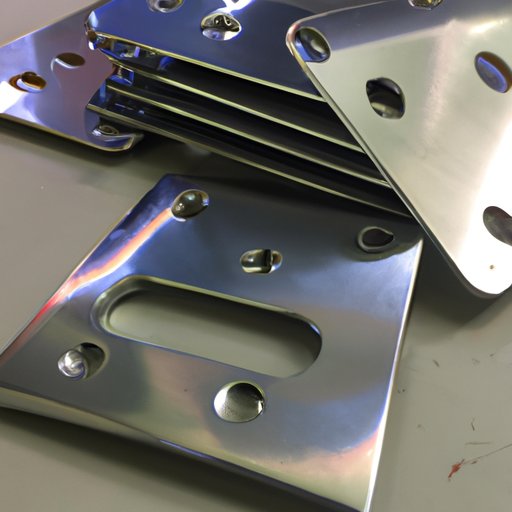Introduction
Plating on aluminum is a process used to apply a protective layer on the surface of aluminum parts that are exposed to extreme wear and tear. This process helps to protect against corrosion and oxidation, as well as improve the overall aesthetic appeal. It can also provide additional strength and durability to the aluminum component, making it more resistant to wear and tear.

Definition of Plating on Aluminum
Plating on aluminum is an electrochemical process in which a thin layer of metal is deposited onto the surface of an aluminum part or component. The metal layer is usually either gold, silver, nickel, zinc, tin, or copper. It is applied to the aluminum part using a special plating machine. The plating process involves submerging the aluminum part into a solution containing ions of the desired metal, and then applying an electrical current that causes the metal ions to become deposited onto the aluminum part.
Overview of Advantages and Challenges
The advantages of plating on aluminum include improved corrosion protection, increased wear resistance, and enhanced aesthetics. Additionally, plating on aluminum can help to reduce friction between moving parts, which can improve performance and reduce noise. However, there are some challenges associated with plating on aluminum, such as the potential for uneven plating thickness or adhesion issues.

Exploring Types of Plating for Aluminum
There are several types of plating available for aluminum, including anodizing, electroplating, chemical conversion coating, and physical vapor deposition. Each of these processes has its own advantages and disadvantages, so it’s important to do your research before deciding which one is best for your application.
Anodizing
Anodizing is a type of electrochemical process in which a thin oxide layer is formed on the surface of the aluminum part. This oxide layer provides excellent corrosion protection, as well as improved wear resistance. Anodizing also gives the aluminum part a distinctive color that can be customized to fit the application. However, anodizing does not provide any additional strength to the aluminum part.
Electroplating
Electroplating is a process in which a thin layer of metal is applied to an aluminum part using an electric current. Common metals used in electroplating include gold, silver, nickel, zinc, tin, and copper. Electroplating can provide superior corrosion protection and improved wear resistance, as well as enhanced aesthetics. However, electroplating is more expensive than other plating processes, and it can be difficult to achieve a uniform coating.
Chemical Conversion Coating
Chemical conversion coating is a process in which a thin layer of metal is applied to an aluminum part using a chemical solution. Common metals used in chemical conversion coating include zinc, tin, and zinc-tin alloys. This process provides excellent corrosion protection, as well as improved wear resistance. However, chemical conversion coating can be difficult to control and is not as durable as other plating processes.
Physical Vapor Deposition
Physical vapor deposition is a process in which a thin layer of metal is applied to an aluminum part using a vacuum chamber. Common metals used in physical vapor deposition include gold, silver, nickel, and copper. This process provides superior corrosion protection and improved wear resistance, as well as enhanced aesthetics. However, physical vapor deposition is more expensive than other plating processes, and it can be difficult to achieve a uniform coating.
How to Plate Aluminum for Long-Term Durability
In order to ensure long-term durability when plating aluminum, it is important to follow a few key steps. First, it is essential to perform pre-treatment processes such as cleaning, etching, and degreasing to ensure proper adhesion. Second, it is important to use high-quality plating solutions and equipment for the plating process. Finally, post-treatment techniques such as polishing, buffing, and sealing should be performed to ensure a smooth and durable finish.
The Benefits of Plating Aluminum for Industrial Applications
Plating aluminum offers numerous benefits for industrial applications. One of the most important benefits is corrosion resistance. Plating aluminum helps to protect against oxidation and rust, which can cause significant damage to components over time. Additionally, plating aluminum can improve the aesthetic appeal of the component, making it more attractive to customers. Finally, plating aluminum can also provide additional strength and durability to the component, making it better suited for heavy-duty applications.

A Comparison of Different Plating Techniques for Aluminum
Anodizing and electroplating are two of the most popular plating techniques for aluminum. Anodizing provides excellent corrosion protection and improved wear resistance, but it does not provide any additional strength to the aluminum part. Electroplating provides superior corrosion protection and improved wear resistance, as well as enhanced aesthetics. However, electroplating is more expensive than anodizing.
Chemical conversion coating and physical vapor deposition are two other plating techniques for aluminum. Chemical conversion coating provides excellent corrosion protection, as well as improved wear resistance. However, it is difficult to control and is not as durable as other plating processes. Physical vapor deposition provides superior corrosion protection and improved wear resistance, as well as enhanced aesthetics. However, physical vapor deposition is more expensive than chemical conversion coating.
Conclusion
Plating on aluminum is an effective way to protect components from corrosion and wear and tear, as well as improve their aesthetic appeal. There are several types of plating available for aluminum, each with its own advantages and disadvantages. It is important to understand the different plating techniques and how to properly plate aluminum for long-term durability. Plating aluminum can offer numerous benefits for industrial applications, including improved corrosion resistance, increased wear resistance, and enhanced aesthetics.

